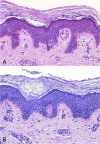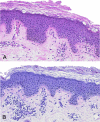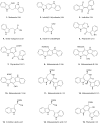The Malassezia genus in skin and systemic diseases
- PMID: 22232373
- PMCID: PMC3255962
- DOI: 10.1128/CMR.00021-11
The Malassezia genus in skin and systemic diseases
Abstract
In the last 15 years, the genus Malassezia has been a topic of intense basic research on taxonomy, physiology, biochemistry, ecology, immunology, and metabolomics. Currently, the genus encompasses 14 species. The 1996 revision of the genus resulted in seven accepted taxa: M. furfur, M. pachydermatis, M. sympodialis, M. globosa, M. obtusa, M. restricta, and M. slooffiae. In the last decade, seven new taxa isolated from healthy and lesional human and animal skin have been accepted: M. dermatis, M. japonica, M. yamatoensis, M. nana, M. caprae, M. equina, and M. cuniculi. However, forthcoming multidisciplinary research is expected to show the etiopathological relationships between these new species and skin diseases. Hitherto, basic and clinical research has established etiological links between Malassezia yeasts, pityriasis versicolor, and sepsis of neonates and immunocompromised individuals. Their role in aggravating seborrheic dermatitis, dandruff, folliculitis, and onychomycosis, though often supported by histopathological evidence and favorable antifungal therapeutic outcomes, remains under investigation. A close association between skin and Malassezia IgE binding allergens in atopic eczema has been shown, while laboratory data support a role in psoriasis exacerbations. Finally, metabolomic research resulted in the proposal of a hypothesis on the contribution of Malassezia-synthesized aryl hydrocarbon receptor (AhR) ligands to basal cell carcinoma through UV radiation-induced carcinogenesis.
Figures













References
-
- Adachi J, Mori Y, Matsui S, Matsuda T. 2004. Comparison of gene expression patterns between 2,3,7,8-tetrachlorodibenzo-p-dioxin and a natural arylhydrocarbon receptor ligand, indirubin. Toxicol. Sci. 80:161–169 - PubMed
-
- Agerberth B, et al. 2006. Malassezia sympodialis differently affects the expression of LL-37 in dendritic cells from atopic eczema patients and healthy individuals. Allergy 61:422–430 - PubMed
-
- Aizawa T, Kano R, Nakamura Y, Watanabe S, Hasegawa A. 2001. The genetic diversity of clinical isolates of Malassezia pachydermatis from dogs and cats. Med. Mycol. 39:329–334 - PubMed
-
- Aizawa T, Kano R, Nakamura Y, Watanabe S, Hasegawa A. 1999. Molecular heterogeneity in clinical isolates of Malassezia pachydermatis from dogs. Vet. Microbiol. 70:67–75 - PubMed
-
- Akaza N, et al. 2009. Malassezia folliculitis is caused by cutaneous resident Malassezia species. Med. Mycol. 47:618–624 - PubMed
Publication types
MeSH terms
LinkOut - more resources
Full Text Sources
Other Literature Sources
Medical

